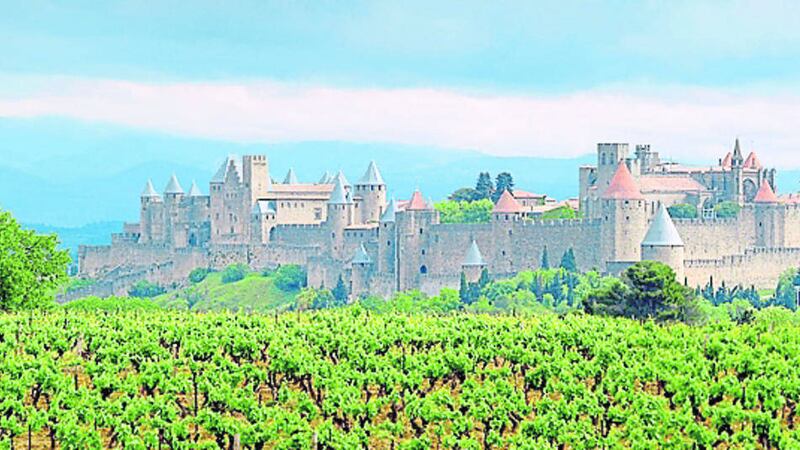THE centuries-battered castle that perches on a small mountain top blends into the landscape, its gnarled towers and ramparts, at a distance, indistinguishable from the rocky outcrop on which it was built.
As a strategic location it is easy to see why Quéribus was an important military stronghold for many hundreds of years. Commanding views for miles around, the Mediterranean shimmers in the distance, while to the south the snow-capped Pyrenees loom between this part of the south of France and the border with Spain.
The 10-minute walk in heat is not too challenging, but a head for heights is essential as the steps up to Quéribus are sometimes separated from plunging cliffs by just a rail or low wall. The earliest parts of the castle are more than 1,000 years old, although it was added to in subsequent centuries during the many battles for territory between France and Spain before being abandoned in the 1600s.
It is believed to be one of the last strongholds of the Cathars, a Christian offshoot that flourished in this part of France between the 12th and 14th centuries. The Cathars were regarded as heretics by the Vatican and its clergy and followers were persecuted and all-but wiped out in the Albigensian Crusade launched by Pope Innocent III in 1209.
Nestling in a valley below is the impossibly picturesque village of Cucugnan where streets spiral upwards along the side of a hill to a old-style windmill. Just outside the village is Terroirs du Vertige, a cooperative of 120 wine producers from the region.
It produces six signature labels of reds, rosé and whites whose logos incorporate the surrounding landscape – the Quéribus label features the castle.
Terroirs du Vertige offers free wine tasting and an insight into how the high altitude at which grapes in the region are grown gives its wines an acidic taste and a concentrated flavour. For an overnight in Cucugnan it is hard to go past the superbly located Auberge Vigneron set in its own gardens, with stylish accommodation and views, from the back rooms, over the vineyards and the mountains, with the castle at Quéribus lurking among the peaks.
The guesthouse also has an excellent restaurant, showcasing regional cuisine made from local ingredients, with an evening soundtrack of cicadas and cuckoos. An hour’s drive northwards is the village of Lagrasse, the sort of place where you often see on one of those property programmes where nice people from Surrey decide they want to downsize and move to. And, to be fair, you couldn’t blame them.
The village grew up around a medieval abbey and is set on the banks of river, which is crossed by a 12th century humpbacked bridge. L'Abbaye Sainte Marie D’Orbie dates from 799 and was founded under a charter from Charlemagne by Benedictine monks – a community of monks still lives in the more modern adjoining part. The earliest architecture is Romaesque but has been added to over the subsequent centuries.
On one of the columns is a startling, almost pornagraphic, carving of a naked woman, apparently to remind the brethren of the evils of the flesh and as a reminder to resist temptation. Not that it did much good, for in the middle ages becoming a monk in this part of France was as much about a lifestyle choice as religious vocation and the sons of rich landowners would join the order, often bringing their servants and setting up home with their wives and children outside the monastery, establishing the village of Lagrasse.
A long, languid lunch or evening meal can be had at the family-run Hostellerie des Corbières which provides regional specialities and products.
The big draw in this part of France is Carcassonne, a walled, medieval city set on a hilltop with 53 watchtowers, double-walled fortifications and castle. You could easily pass a couple of days wandering its twisting cobbled streets, dining in its many fine cafes and restaurants and poking around a mixture of artisan and gift shops.
There are more than three kilometers of undulating ramparts, while the a tour of the castle incorporates a museum tracing the 1,700-year history of the citadel. A highlight is the Church of Saint Vincent, the earliest parts of which date from the 11th century but which was expanded in the 13th century in the gothic style.
Gargoyles lurk beneath the eaves outside while inside are two beautiful rose stain-glass windows, a window depicting the ‘tree of life’, a marble altar and statues carved into pillars. Next to it, on the site of the former bishop’s residence, is the elegant and luxurious five-star Hotel de la Cité.
Fine dining and superb regional wines within the city walls can be found at Comte Roger whose amiable chef Pierre Mesa is on hand to talk you through the menu and wine list.
Cassoulet is the signature dish of the region – a combination of white beans, sausages, mutton and duck – and one of the finest places to taste it is in Brasserie du Donjon, also inside the citadel’s ramparts.
Another culinary highlight can found a few miles outside Carcassonne at the Michelin star Domaine d’Auriac, a 300-year-old villa set in its own grounds with an 18-hole golf course accommodation.
And if after all that food you are up for some more wine tasting the excellent vineyard of Domaine d’Auzias is a few kilometers outside Carcassonne.
‘La Ville Basse’, the more modern part of Carcassone, set across the river from the citadel, is an easily navigable small city with a superb market, quirky museum and stunning views across its rooftops and surrounding countryside from the tower of St Vincent’s church, if you can manage the 232 twisting, stone steps.
Running through the city is Canal du Midi which was built in the 17th century and runs from Toulouse to the Mediterranean. Boat tours depart from close to the train station, through a series of locks and into the countryside with views over to forest-clad Black Mountains, although it you fancy a bit of hiking be careful as wolves are said to still hunt there.
FACTFILE
:: The website at rendezvousenfrance.com provides visitors with access to information on the latest news and apps, upcoming events and practical information about France.
:: For more regional information see on Carcassonne and Aude visit:
http://www.audetourisme.com and www.carcassonne-tourisme.com.
:: Ryanair flies a return service to Carcassonne from Dublin. ryanair.com
:: Useful websites
- Carcassonne
hotel-trois-couronnes.fr
carcassonne-navigation.com
auzias.fr
- Cucugnan
cucugnan.fr
terroirsduvertige.com
auberge-vigneron.com
- Lagrasse
abbayedelagrasse.com
hostellerie-des-corbieres.com







